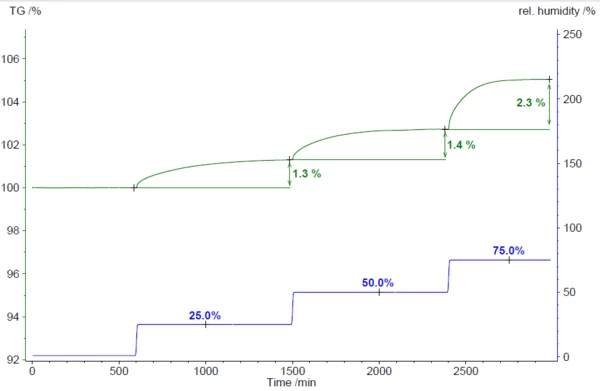
19.05.2020 by Milena Riedl
Identify Water Absorption and Determine Moisture Content with Thermogravimetric Analysis
Water is one of the major parts influencing our climate. Our atmosphere is filled with water. We may not always be able to see it, but it interacts with us and our materials. Learn how thermal analysis helps identify water absorption and determine water content.
together with Dr. Michael Schöneich, Application Specialist

Water is one of the major parts influencing our climate. Our atmosphere is filled with water. We may not always be able to see it, but it interacts with us and our materials.
One of the best known examples of humidity in our daily life can be observed when taking a bottle of water out of the freezer on a hot summer day. Almost immediately, water drops appear on the surface of the water bottle. These water drops are the result of condensed water vapor from the atmosphere.
We are surrounded by water
Humidity does not only appear in our daily life, but also influences materials by causing physical and chemical interactions.
A physical interaction can be the absorption of water, which leads to the expansion of materials. If a substance or material reacts with water, a new compound is formed. The most prominent example of such a chemical reaction is the corrosion of steel.
As a result, the interaction of water with materials results in property changes (e.g., reduced stability due to corrosion) and/or appearance or optical changes (e.g., humidity streaks in injection molding parts).

Hands-on: TGA measurements under humid atmospheres
What is Thermogravimetry?
Thermogravimetric analysis is a method of thermal analysis in which the mass of a sample is measured over time as the temperature changes. This measurement provides information about physical phenomena, such as Phase TransitionsThe term phase transition (or phase change) is most commonly used to describe transitions between the solid, liquid and gaseous states.phase transitions, absorption and desorption; as well as chemical phenomena including thermal Reakcja rozkładu (dekompozycji)A decomposition reaction is a thermally induced reaction of a chemical compound forming solid and/or gaseous products. decomposition, and Solid-Gas ReactionsSolid-gas reactions are a type of heterogeneous solid-state reaction occurring when a reactive solid is exposed to a stream of reactive gas. Typical examples of solid-gas reactions are sorption and corrosion of metals.solid-gas reactions (e.g., OxidationOxidation can describe different processes in the context of thermal analysis.oxidation or reduction).
An example from the field of polymers
The aim of the following analysis was the determination of the mass change of the material in a humid atmosphere. Therefore, an STA 449 F3 Jupiter® was equipped with a humidity generator that produces a defined humidity level by mixing wet and dry gas flow.
The experiment was carried out on a 250-μm foil sample of polyamide 6 with a weight of 108.28 mg. The temperature was held constant at 40°C and humidity steps of 25 % were performed during the temperature program (blue curve in figure 3).

In figure 3, the green curve represents the mass change. At each humidity step, there is a response from the sample as its mass increases. The sample absorbs water and its moisture content increases with the humidity content of the surrounding atmosphere.
Furthermore, the process of absorption is time-depended. This means that there are kinetic influences, which can also be analyzed. The diffusion coefficient of the material can be determined with the help of the humidity setup.
The example shows that TGA as a standard method is useful to identify physical interactions of materials with humidity. Additionally, it is possible to determine the quantitative value of the water absorption content.
An application from the field of inorganics
In this application, zeolite was investigated with a STA 449 F3 Jupiter under a humid atmosphere. Zeolite is an absorption material that can be used for cleaning gas flows or for water absorption in certain rooms and areas.
To test the performance of zeolite, two absorption/desorption cycles were performed at a constant temperature of 20°C and a relative humidity of 10 %.

First, there is an increase in mass as a humid atmosphere is applied to the sample. The material takes up a certain amount of water which, in turn, increases its mass. In the dry gas flow, the material releases water. The first cycle acts as a test cycle to test the maximum absorption capacity.
The cycles can be repeated a few times to test the cycle stability of the material. After the first activation, the water release is slightly less, which means the material is relatively stable in its application with a water uptake of around 26%.
The two examples of the identification of water absorption and the determination of the water content show that thermogravimetric analysis is a suitable method to analyze the effects of humidity on a material or substance.
In the next blog articles, special focus will be put on the influence of water on the mechanical properties and on the determination of the extension of materials due to water uptake.